If I may, I want to stress the importance of this war to Indians. This really shows the bravery and valor of the Marathas! And basically NO Indians knows about his war and its importance to our modern nation. SO PLEASE READ! Because its way more important then any other modern war that India fought.
*27 Maratha Year War That Changed Course Of Indian History*
Schoolchildren in India learn a very specific blend of Indian history. This school version of history is stripped of all the vigor and pride. The story of Indian civilization spans thousands of years. However for the most part the schoolbook version dwells on the freedom struggle against British and important role played in there by the Indian National Congress. We learn each and every movement of Gandhi and Nehru, but not even a passing reference is made to hundreds of other important people and events.
My objection is not to the persons Gandhi or Nehru. However the attention they get and the exposure their political views and ideology gets is rather disproportionate.
And thus it comes no surprise to me that rarely we talk about an epic war that significantly altered the face of Indian subcontinent. The war that can be described the mother of all wars in India. Considering the average life expectancy that time was around 30 years, this war of 27 years lasted almost the lifespan of an entire generation. The total number of battles fought was in hundreds. It occurred over vast geographical expanse spanning four biggest states of modern India- Maharashtra, Gujarat, Madhya Pradesh and Karnataka. For time, expanse and human and material cost, this war has no match in Indian history.
It started in 1681 with the Mughal emperor Aurangzebs invasion of Maratha empire. It ended in 1707 with Aurangzebs death. Aurangzeb threw everything he had in this war. He lost it all.
Its tempting to jump into the stories of heroics, but what makes the study of war more interesting is the understanding of politics behind it. Every war is driven by politics. Rather war is just one of the means to do politics. This war was not an exception.
Shivajis tireless work for most of his life had shown fruits by the last quarter of seventeenth century. He had firmly established Marathas as power in Deccan. He built hundreds of forts in Konkan and Sahyadris and thus created a defense backbone. He also established strong naval presence and controlled most of the Western ports barring few on end of Indian peninsula. Thus tightening the grip on trade routes of Deccan sultanates, he strangled their weapons import from Europe and horses import from Arabian traders. These Sultanates launched several campaigns against Shivaji, but failed to stop him.
On the Northern front, several Rajput kings had accepted to be the vassals of Mughals. Aurangzeb had succeeded to the throne after brutal killing of his brothers and imprisonment of his father. With Rajput resistance mostly subsided and the southern sultanates weakened, it was only matter of time before Marathas were in his cross-hair.
At the time of Shivajis death in 1680, Maratha empire spanned an area far more than the current state of Maharashtra and had taken firm roots. But it was surrounded by enemies from all sides. Portuguese on northern Coast and Goa, British in Mumbai, Siddies in Konkan and remaining Deccan sultenates in Karnataka posed limited challenge each, but none of them was capable of taking down the Marathas alone. Mughal empire with Aurangzeb at its helm was the most formidable foe.
For the most part, Aurangzeb was a religious fanatic. He had distanced Sikhs and Rajputs because of his intolerant policies against Hindus. After his succession to the throne, he had made life living hell for Hindus in his kingdom. Taxes like Jizya tax were imposed on Hindus. No Hindu could ride in Palanquin. Hindu temples were destroyed and abundant forcible conversions took place. Auragzeb unsuccessfully tried to impose Sharia, the Islamic law. This disillusioned Rajputs and Sikhs resulting in their giving cold shoulder to Aurangzeb in his Deccan campaign.
Thus in September of 1681, after settling his dispute with the royal house of Mewar, Aurangzeb began his journey to Deccan to kill the Maratha confederacy that was not even 50 years old. On his side, the Mughal king had enormous army numbering half a million soldiers, a number more than three times that of the Maratha army. He had plentiful support of artillery, horses, elephants. He also brought huge wealth in royal treasuries. Teaming up with Portughese, British ,Siddis, Golkonda and Bijapur Sultanates he planned to encapsulate Marathas from all sides and to form a deadly death trap. To an outsider, it would seem no-brainer to predict the outcome of such vastly one sided war. It seemed like the perfect storm headed towards Maratha confederacy.
Enormous death and destruction followed in Deccan for what seemed like eternity. But what happened at the end would defy all imaginations and prove every logic wrong. Despite lagging in resources on all fronts, it would be the Marathas who triumphed. And at the expense of all his treasure, army, power and life, it would be the invading emperor who learned a very costly lesson, that the will of people to fight for their freedom should never be underestimated
Timeline Marathas under King Sambhaji (1680 to 1689):
After the death of Shivaji in 1680, a brief power struggle ensued in the royal family. Finally Sambhaji became the king. By this time Aurangzeb had finished his North missions and was pondering a final push in Deccan to conquer all of the India.
In 1681 sambhaji attacked Janjira, but his first attempt failed. In the same time one of the Aurangzebs generals, Hussein Ali Khan , attacked Northern Konkan. Sambhaji left janjira and attacked Hussein Ali Khan and pushed him back to Ahmednagar. By this time mansoon of 1682 had started. Both sides halted their major military operations. But Aurangzeb was not sitting idle. He tried to sign a deal with Portughese to allow mughal ships to harbor in Goa. This would have allowed him to open another supply route to Deccan via sea. The news reached sambhaji. He attacked Portughese territories and pushed deep inside Goa. But Voiceroy Alvor was able to defend Portughese headquarters.
By this time massive Mughal army had started gathering on the borders of Deccan. It was clear that southern India was headed for one big conflict.
Sambhaji had to leave Portughese expedition and turn around. In late 1683, Aurangzeb moved to Ahmednagar. He divided his forces in two and put his two princes, Shah Alam and Azam Shah, in charge of each division. Shah alam was to attack South Konkan via Karnataka border while Azam Shah would attack Khandesh and northern Maratha territory. Using pincer strategy, these two divisions planned to circle Marathas from South and North and isolate them.
The beginning went quite well. Shah Alam crossed Krishna river and enterd Belgaum. From there he entered Goa and started marching north via Konkan. As he pushed further,he was continuously harassed by Marathas. They ransacked his supply chains and reduced his forces to starvation. Finally Aurangzeb sent Ruhulla Khan for his rescue and brought him back to Ahmednagar. The first pincer attempt failed.
After 1684 monsoon, Aurangzebs another general Sahabuddin Khan directly attacked the Maratha capital, fort Raygad. Maratha commanders successfully defended Raygad. Aurangzeb sent Khan Jehan for help, but Hambeerrao Mohite, Commander-in-Chief of Maratha army, defeated him in a fierce battle at Patadi. Second division of Maratha army attacked Sahabuddin Khan at Pachad, inflicting heavy losses on Mughal army.
In early 1685, Shah Alam attacked South again via Gokak- Dharwar route. But Sambhajis forces harassed him continuously on the way and finally he had to give up and thus failed to close the loop second time.
In april 1685 Aurangzeb rehashed his strategy. He planned to consolidate his power in the South by taking expediations to Goalkonda and Bijapur. Both were Shia muslim rulers and Aurangzeb was no fond of them. He broke his treaties with both empires and attacked them. Taking this opportunity Marathas launched offensive on North coast and attacked Bharuch. They were able to evade the mughal army sent their way and came back with minimum damage.
On Aurangzebs new Southern front, things were proceeding rather smoothly. Bijapur fell in September 1686. King Sikandar Shah was captured and imprisoned. Goalkonda agreed to pay huge ransom. But after receiving the money, Aurangzeb attacked them in blatant treachery. Soon Goalkonda fell as well. King Abu Hussein of Goalkonda was captured and met the same fate as Sikandar Shah.
Marathas had tried to win mysore through diplomacy. Kesopant Pingle, (Moropant Pingles brother) was running negotiations, but the fall of Bijapur to mughals turned the tides and Mysore was reluctant to join Marathas. Still Sambhaji successfully courted several Bijapur sardars to join Maratha army.
After fall of Bijapur and Goalkonda, Aurangzeb turned his attention again to his main target Marathas. First few attempts proved unsuccessful to make a major dent. But in Dec 1688 he had his biggest jackpot. Sambhaji was captured at Sangmeshwar. It was in part his own carelessness and in part because of treachery. Aurangzeb gave him option of converting to Islam, which he refused. Upon refusal, Aurangzeb, blinded by his victories, gave Sambhaji the worst treatment he could ever give to anyone. Sambhaji was pareded on donkey. His tounge was cut, eyes were gorged out. His body was cut into pieces and fed to dogs.
There were many people who did not like Sambhaji and thus were sympathetic to Mughals. But this barbaric treatment made everyone angry. Maratha generals gathered on Raygad. The decision was unanimous. All peace offers were to be withdrawn. Mughals would be repelled at all costs. Rajaram succeeded as the next king. He began his reign by a valiant speech on Raygad. All Maratha generals and councilmen united under the flag of new king, and thus began the second phase of the epic war.
27 Years War TimeLine Marathas under King Rajaram (1689 to 1700)
To Aurangzeb, the Marathas seemed all but dead by end of 1689. But this would prove to be almost a fatal blunder. In March 1990, the Maratha commanders, under the leadership of Santaji Ghorpade launched the single most daring attack on mughal army. They not only attacked the army, but sacked the tent where the Aurangzeb himself slept. Luckily Aurangzeb was elsewhere but his private force and many of his bodyguards were killed.
This positive development was followed by a negative one for Marathas. Raigad fell to treachery of Suryaji Pisal. Sambhajis queen, Yesubai and their son, Shahu, were captured.
Mughal forces, led by Zulfikar Khan, continued this offensive further South. They attacked fort Panhala. The Maratha killedar of Panhala gallantly defended the fort and inflicted heavy losses on Mughal army. Finally Aurangzeb himself had to come. Panhala surrendered.
Maratha ministers had foreseen the next Mughal move on Vishalgad. They made Rajaram leave Vishalgad for Jinji, which would be his home for next seven years. Rajaram travelled South under escort of Khando Ballal and his men. The queen of Bidnur, gave them supplies and free passage. Harji Mahadiks division met them near Jinji and guarded them to the fort. Rajarams queen was escorted out of Maharashtra by Tungare brothers. She was taken to Jinji by different route. Ballal and Mahadik tirelessly worked to gather the scattered diplomats and soldiers. Jinji became new capital of Marathas. This breathed new life in Maratha army.
Aurangzeb was frustrated with Rajarams successful escape. His next move was to keep most of his force in Maharashtra and dispatch a small force to keep Rajaram in check. But the two Maratha generals, Santaji ghorpade and Dhanaji Jadhav would prove more than match to him.
They first attacked and destroyed the force sent by Aurangzeb to keep check on Rajaram, thus relieving the immediate danger. Then they joined Ramchandra Bavadekar in Deccan. Bavdekar, Vithoji Bhosale and Raghuji Chavan had reorganized most of the Maratha army after defeats at Panhala and Vishalgad.
In late 1691, Bavdekar, Pralhad Niraji , Santaji ,Dhanaji and several Maratha sardars met in Maval region and reformed the strategy. Aurangzeb had taken four major forts in Sahyadrais and was sending Zulfikar khan to subdue the fort Jinji. So according to new Maratha plan, Santaji and Dhanaji would launch offensives in the East to keep rest of the Mughal forces scattered. Others would focus in Maharashtra and would attack a series of forts around Southern Maharashtra and Northern Karnataka to divide Mughal won territories in two, thereby posing significant challenge to enemy supply chains. Thanks to Shivajis vision of building a navy, Marathas could now extend this divide into the sea, checking any supply routes from Surat to South.
The execution began. In early 1692 Shankar Narayan and Parshuram Trimbak recaptured Rajgad and Panhala. In early 1693 Shankar Narayan and Bhosale captured Rohida. Sidhoji Gujar took Vijaydurg. Soon Parshuram Trimbak took Vishalgad. Kanhoji Angre, a young Maratha Naval officer that time, took fort Kolaba.
While this was in work, Santaji and Dhanaji were launching swift raids on Mughal armies on East front. This came as a bit of surprise to Aurangzeb. In spite of losing one King and having second king driven away, Marathas were undaunted and actually were on offensive. From Khandesh, Ahmednagar to Bijapur to Konkan and Southern Karnataka, Santaji and Dhanaji wrecked havoc. Encouraged by the success, Santaji and Dhanaji hatched new action plan to attack Mughal forces near Jinji. Dhanaji Jadhav attacked Ismail Khan and defeated him near Kokar. Santaji Ghorpade attacked Ali Mardan Khan at the base of Jinji and captured him. With flanks cleared, both joined hands and laid a second siege around the Mughal siege at Jinji
Julfikar khan, who was orchestrating Jinji siege, left the siege on Aurangzebs orders and marched back. Santaji followed him to North, but was defeated by Julfikar Khan. Santaji then diverted his forces to Bijapur. Aurangzeb sent another general Kasim Khan to tackle Santaji. But Santaji attacked him with a brilliant military maneuver near Chitaldurg and forced him take refuge in Dunderi fort. The fort was quickly sieged by Santaji and the siege only ended when most of the Mughal soldiers starved and Kasim Khan committed suicide. Aurangzeb sent Himmat Khan to reinforce Kasim Khan. Himmat khan carried heavy artillery. So Santaji lured him in a trap in the forest near Dunderi. A sudden, ambush style attack on Mughals was followed by a fierce battle. The battle ended when when Himmat Khan was shot in head and died. All his forces routed and Santaji confiscated a big cache of weapons and ammunition.
By now, Aurangzeb had the grim realization that the war he began was much more serious than he thought. He consolidated his forces and rethought his strategy. He sent an ultimatum to Zulfikar khan to finish Jinji business or be stripped of the titles. Julfikar khan tightened the Siege. But Rajaram fled and was safely escorted to Deccan by Dhanaji Jadhav and Shirke brothers. Haraji Mahadiks son took the charge of Jinji and bravely defended Jinji against Julfikar khan and Daud khan till January of 1698. This gave Rajaram ample of time to reach Vishalgad.
Jinji fell, but it did a big damage to the Mughal empire. The losses incurred in taking Jinji far outweighed the gains. The fort had done its work. For seven years the three hills of Jinji had kept a large contigent of mughal forces occupied. It had eaten a deep hole into Mughal resources. Not only at Jinji, but the royal treasury was bleeding everywhere and was already under strain.
Marathas would soon witness an unpleasant development, all of their own making. Dhanaji Jadhav and Santaji Ghorpade had a simmering rivalry, which was kept in check by the councilman Pralhad Niraji. But after Nirajis death, Dhanaji grew bold and attacked Santaji. Nagoji Mane, one of Dhanajis men, killed Santaji. The news of Santajis death greatly encouraged Aurangzeb and Mughal army.
But by this time Mughals were no longer the army they were feared before. Aurangzeb, against advise of several of his experienced generals, kept the war on. It was much like Alexander on the borders of Taxila.
The Marathas again consolidated and the new Maratha counter offensive began. Rajaram made Dhanaji the next commander in chief. Maratha army was divided in three divisions. Dhanaji would himself lead the first division. Parshuram Timbak lead the second and Shankar Narayan lead the third. Dhanaji Jadhav defeated a large mughal force near Pandharpur. Shankar Narayan defeated Sarja Khan in Pune. Khanderao Dabhade, who lead a division under Dhanaji, took Baglan and Nashik. Nemaji Shinde, another commander with Shankar Narayan, scored a major victory at Nandurbar.
Enraged at this defeats, Aurangzeb himself took charge and launched another counter offensive. He laid siege to Panhala and attacked the fort of Satara. The seasoned commander, Prayagji Prabhu defended Satara for a good six months, but surrendered in April of 1700, just before onset of Monsoon. This foiled Aurangzebs strategy to clear as many forts before monsoon as possible.
In March of 1700, another bad news followed Marathas. Rajaram took his last breath. His queen Tarabai, who was also daughter of the gallant Maratha Commander-in-Chief Hambeerrao Mohite, took charge of Maratha army. Daughter of a braveheart, Tarabai proved her true mettle for the next seven years. She carried the struggle on with equal valor. Thus began the phase 3, the last phase of the prolonged war, with Marathas under the leadership of Tarabai.
The signs of strains were showing in Mughal camp in late 1701. Asad Khan, Julfikar Khans father, counselled Aurangzeb to end the war and turn around. This expedition had already taken a giant toll, much larger than originally planned, on Mughal empire. And serious signs were emerging that the 200 years old Mughal empire was crumbling and was in the middle of a war that was not winnable
Mughals were bleeding heavily from treasuries. But Aurangzeb kept pressing the war on. When Tarabai took charge, Aurangzeb had laid siege to the fort of Parli (Sajjangad). Parshuram Trimbak defended the fort until mansooon and retreated quietly at the break of monsoon.The mughal army was dealt heavy loss by flash floods in the rivers around. These same tactics were followed by Marathas at the next stop of Aurangzeb, Panhala. Similar tactic was followed even for Vishalgad.
By 1704, Aurangzeb had Torana and Rajgad. He had won only a handful forts in this offensive, but he had spent several precious years. It was slowly dawning to him that after 24 years of constant war, he was no closer to defeating Marathas than he was the day he began.
The final Maratha counter offensive gathered momentum in North. Tarabai proved to be a valiant leader once again. One after another Mughal provinces fell in north. They were not in position to defend as the royal treasuries had been sucked dry and no armies were left in town. In 1705, two Maratha army factions crossed Narmada. One under leadership of Nemaji Shinde hit as deep North as Bhopal. Second under the leadership of Dabhade struck Bharoch and West. Dabhade with his eight thousand men,attacked and defeated Mahomed khans forces numbering almost fourteen thousand. This left entire Gujarat coast wide open for Marathas. They immediately tightened their grip on Mughal supply chains.
In Maharashtra, Aurangzeb grew despondent. He started negotiations with Marathas, but cut abruptly and marched on a small kingdom called Wakinara. Naiks at Wakinara traced their lineage to royal family of Vijaynagar empire. They were never fond of Mughals and had sided with Marathas. Dhanaji marched into Sahyadris and won almost all the major forts back in short time. Satara and Parali forts were taken by Parshuram Timbak. Shankar Narayan took Sinhgad. Dhanaji then turned around and took his forces to Wakinara. He helped the Naiks at Wakinara sustain the fight. Naiks fought very bravely. Finally Wakinara fell, but the royal family of Naiks successfully escaped with least damage.
Aurangzeb had now given up all hopes and was now planning retreat to Burhanpur. Dhanaji Jadhav again fell on him and in swift and ferocious attack and dismantled the rear guard of his imperial army. Zulfikar Khan rescued the emperor and they successfully reached Burhanpur.
Aurangzeb witnessed bitter fights among his sons in his last days. Alone, lost, depressed, bankrupt, far away from home, he died sad death on 3rd March 1707. I hope god will forgive me one day for my disastrous sins, were his last words.
Thus ended a prolonged and grueling period in history of India. The Mughal kingdom fragmented and disintegrated soon after. And Deccan saw rise of a new sun, the Maratha empire.



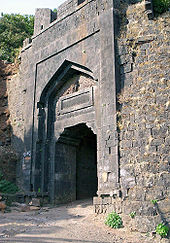
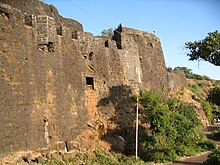

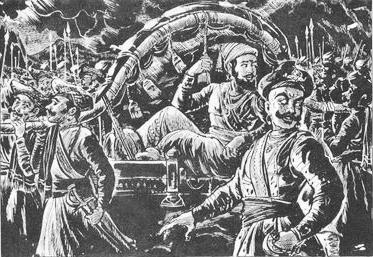









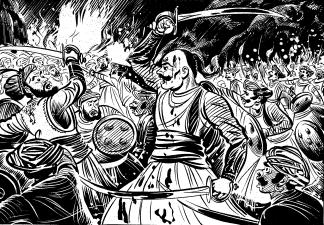



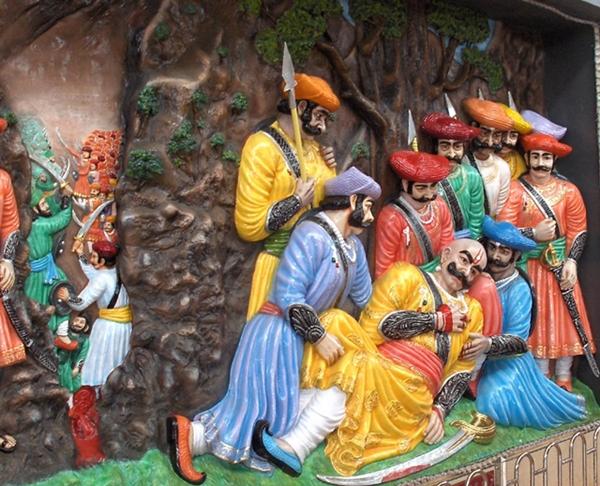


 )
)

